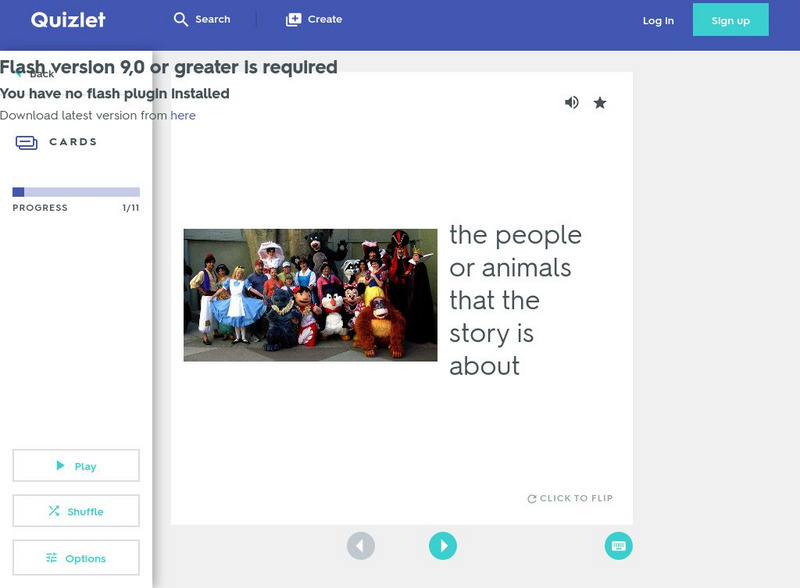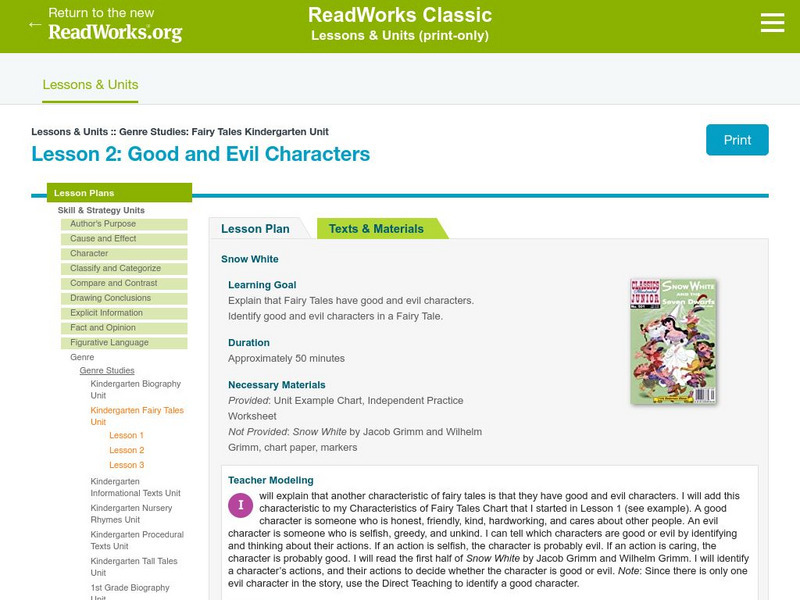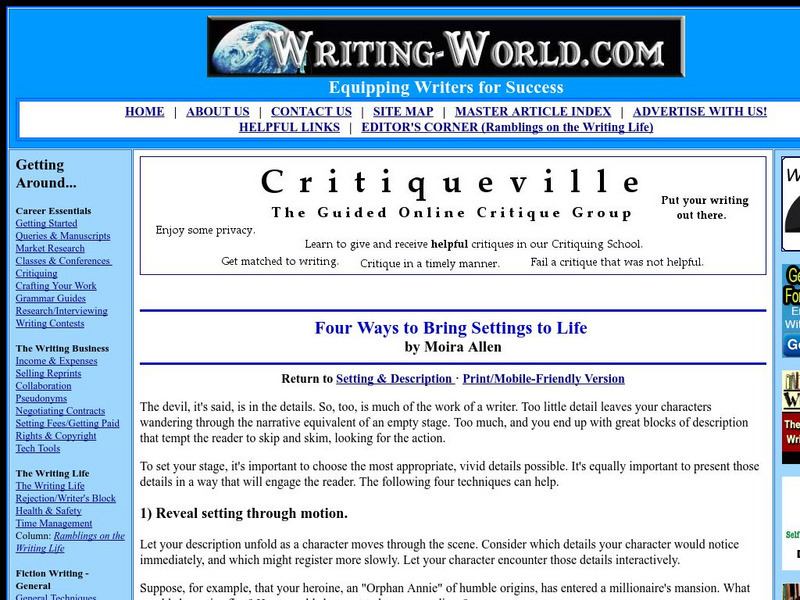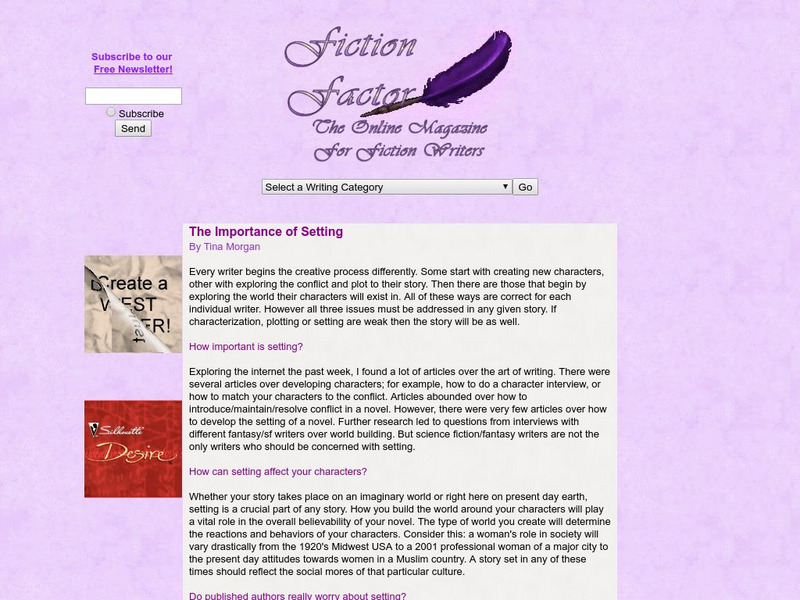Quizlet
Quizlet: Story Elements (1St Grade) Match
This interactive game of "Match" assesses students' knowledge of story element definitions. Students will match the correct definition of a story element to its corresponding definition. Picture cues are provided on this review resource.
Quizlet
Quizlet: Story Elements (1St Grade): Flashcards
These interactive flashcards provide definitions for different story elements. Engaging picture cues are provided for each flashcard, and students can play the audio to hear the words and definitions read aloud.
Read Works
Read Works: Lesson 2: Good and Evil Characters
This lesson will allow young scholars to understand why Fairy Tales have good and evil characters and identify good and evil characters in a Fairy Tale.
Better Lesson
Better Lesson: rl.k.3 With Prompting and Support, Identify Characters, Settings,
This landing page provides different lesson plan choices on teaching RL.K.3 With prompting and support, identify characters, settings,
Quizlet
Quizlet: R.3 Analyze How and Why Individuals, Events, or Ideas, Develop/interact
Please align to CCSS.ELA-Literacy.CCRA.R.3 Analyze how and why individuals, events, and ideas develop and interact over the course of a text.
Other
Writing World: Four Ways to Bring Settings to Life
A great resource outlining four major ways to make settings appear more real and genuine in fiction. Deals with themes such as motion, experience, mood, and the senses. W.11-12.3d Sensory/precise lang narratives
Success Link
Success Link: Characters, Setting, Plot, Conclusion, and Summarizing a Story
This lesson plan offers a step-by-step procedure for teaching students how to identify story elements and to summarize a story. It explains how to use a "Who Am I" activity, as well as a linkage activity in identifying characters and...
Other
Fiction Factor: The Importance of Setting
An interesting article concerning the importance of setting to any piece of fiction. Gives good information about how setting affects characters and "world-building."
Alabama Learning Exchange
Alex: Using Fairy Tales to Teach the Short Stories
Familiar fairy tales are used as guides to help students analyze the elements of the short story: plot, theme, setting, point of view, and character.
Alabama Learning Exchange
Alex: "Hot Dog" Book Reports
Students will use a Makes Sense Strategies Think-sheet to learn to identify the characters, setting, main idea and details of a book read. [Requires Adobe Reader.]
Alabama Learning Exchange
Alex: "Little House on the Prairie"
Using Little House In The Big Woods by Laura Ingalls Wilder, this lesson focuses on the concept of time and place, phonics, and comprehension strategies. It is an interactive lesson with classroom dialogue and small group interaction.
Alabama Learning Exchange
Alex: To Kill a Mockingbird: Building Knowledge
As a conclusion to a class study of Harper Lee's To Kill a Mockingbird, students create models and pictures based on the novel's descriptions to illustrate the effect of setting on plot and character.
PBS
Pbs Learning Media: The Emperor's New Clothes: Text
This is adapted from Hans Christian Andersen's tale, "The Emperor's New Clothes" in text format.
PBS
Pbs Learning Media: Rumpelstiltskin: Text
This is an adaptation of the fairy tale "Rumpelstiltskin" in text form.
PBS
Pbs Learning Media: Interpreting Characters, Setting, Plot, & Theme: Triangle...
Middle schoolers will view video documenting the real-life story of the Triangle Shirtwaist Factory fire in 1911. Students will complete a story elements graphic organizer. This organizer will help them distinguish various story elements...
British Library
British Library: 20th Century: Creative Activities
Channel your creativity with these writing activities.
Louisiana Department of Education
Louisiana Doe: Louisiana Believes: English Language Arts: Grade 6: Out of the Dust
Focused on the Dust Bowl and how families fought for a meaningful existence and survival, this unit will offer students different perspectives on how people respond to adversity, the lessons that can be learned from hardship and failure,...
Louisiana Department of Education
Louisiana Doe: Louisiana Believes: English Language Arts: Grade 6: The Witch of Blackbird Pond
Sixth graders will learn about the influence of family expectations and religious values on the development of one's personal identity. Students will also learn how reading informational texts in coordination with literary texts can...
Louisiana Department of Education
Louisiana Doe: Louisiana Believes: English Language Arts: Grade 7: A Christmas Carol
Seventh graders learn that writers use stories and distinctive characters to teach us lessons. Students will explore how the choices of characters affect the plot and build the theme of a story. Students will come to understand that...
Louisiana Department of Education
Louisiana Doe: Curriculum Hub: Ela Guidebooks: Romeo and Juliet: Setting
Students build their knowledge of a text's setting by reading background information and answering questions to prepare to read Romeo and Juliet.
Google
Louisiana Curriculum Hub: Ela Guidebooks: Grade 5: The Birchbark House: Unit Files
A Google Drive folder with instructional presentations, discussion questions, student activities, and assessments for the book, The Birchbark House.
ArtsNow
Arts Now Learning: The Color Monster [Pdf]
Explore how our emotions color our lives and add depth to our stories.
AdLit
Ad lit.org: Classroom Strategies: Story Maps
Story Maps are used for teaching students to work with story structure for better comprehension. This technique uses visual representations to help students organize important elements of a story. Students learn to summarize the main...
Ted Nellen
Cyber English (By Ted Nellen): Literary Terms S Z
The third of three pages of simple definitions for literary terms. This page, S - Z, covers twenty-two terms from "Saga," to "Understatement."













